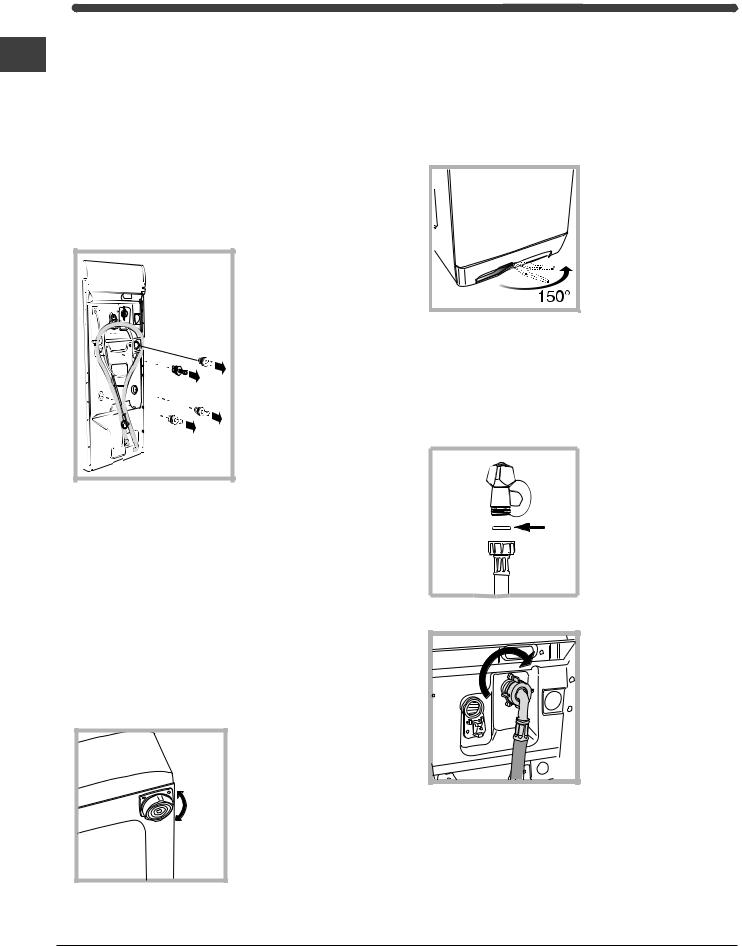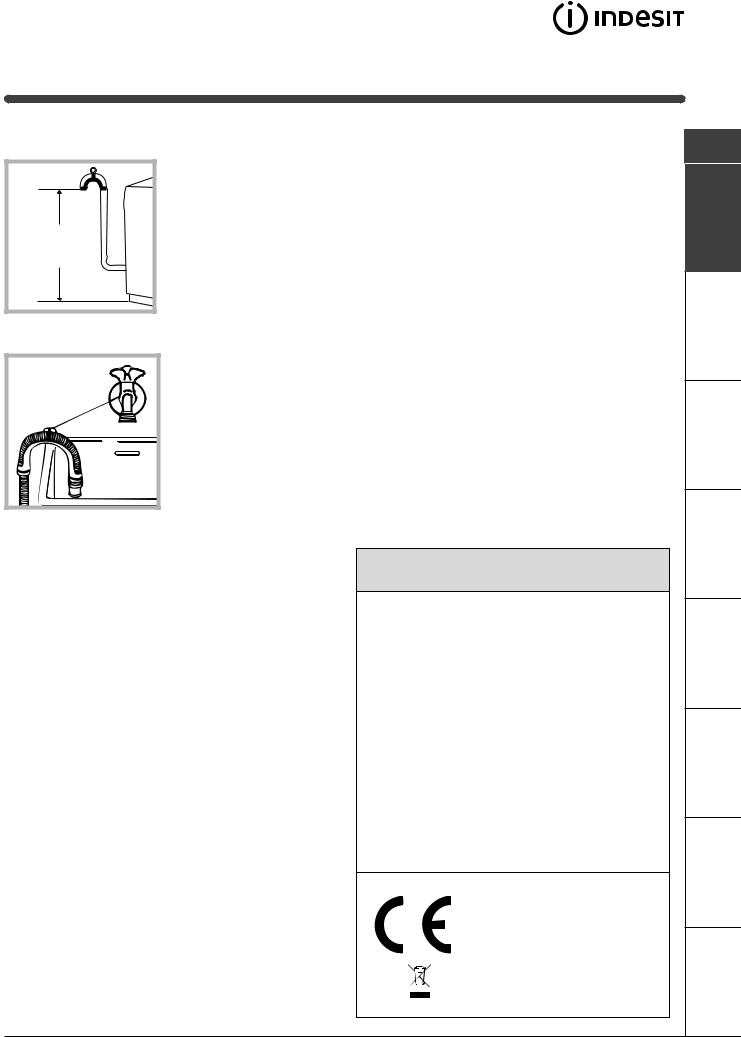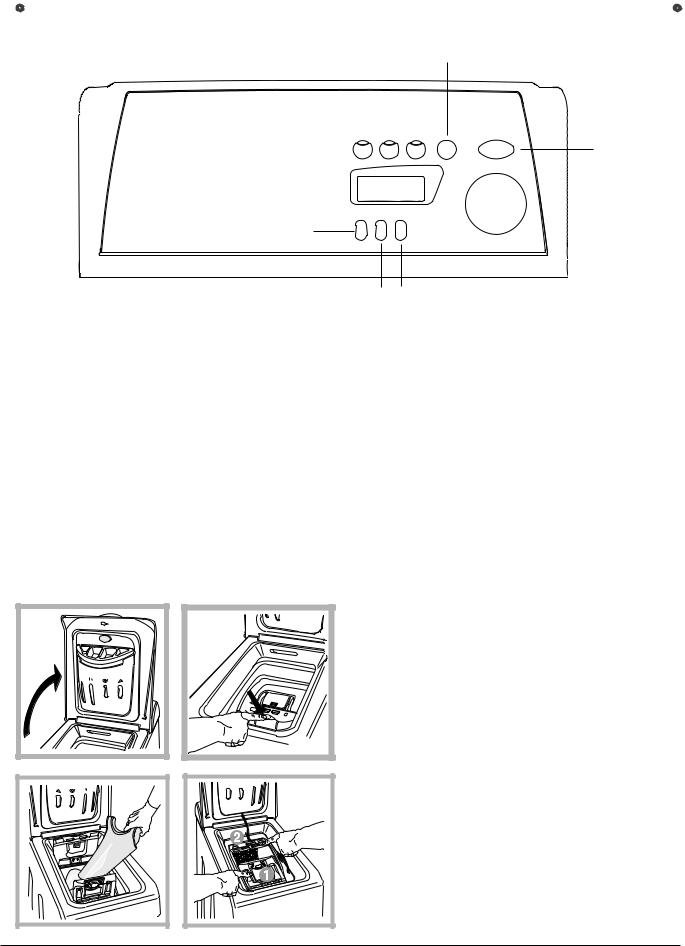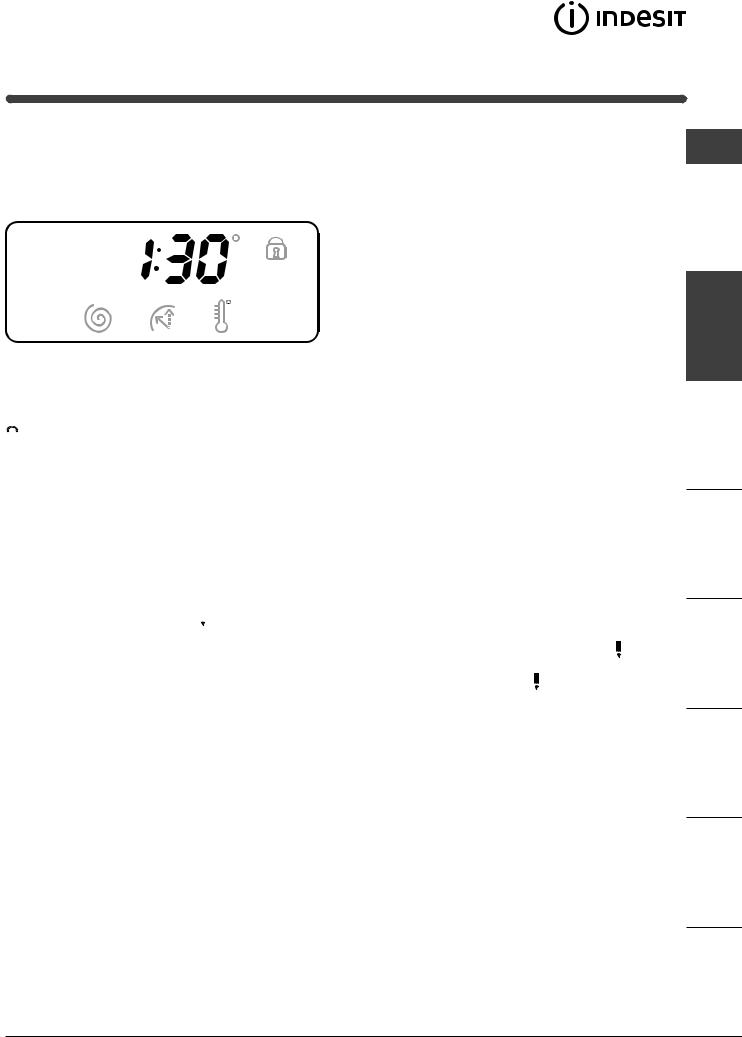Indesit WITE 107 User Manual

Instructions for use
GB |
|
IT |
|
|
|
|
|
English, 1 |
Italiano, 13 |
||
WASHING MACHINE
Contents
GB
Installation, 2-3
Unpacking and levelling, 2
Electric and water connections, 2-3 The first wash cycle, 3
Technical details, 3
Washing machine description, 4-5
Control panel, 4
How to open and shut the drum, 4 Display, 5
“MEMO” Programme, 5
|
Starting and Programmes, 6 |
|
Briefly: how to start a programme, 6 |
|
Programme table, 6 |
WITE 107 |
Personalisations, 7 |
Setting the spin cycle, 7 |
|
|
Setting the Delay Timer, 7 |
|
Setting the temperature, 7 |
|
Functions, 7 |
|
Detergents and laundry, 8 |
|
Detergent dispenser, 8 |
|
Bleach cycle, 8 |
|
Preparing your laundry, 8 |
|
Special items, 8 |
|
Precautions and advice, 9 |
|
General safety, 9 |
|
Disposal, 9 |
|
Saving energy and respecting the environment, 9 |
|
Care and maintenance, 10 |
|
Cutting off the water or electricity supply, 10 |
|
Cleaning your appliance, 10 |
|
Cleaning the detergent dispenser, 10 |
|
Caring for your appliance door and drum, 10 |
|
Cleaning the pump, 10 |
|
Checking the water inlet hose, 10 |
|
Cleaning the detergent dispenser, 10 |
|
Troubleshooting, 11 |
|
Service, 12 |
|
Before calling for Assistance, 12 |
1

Installation
Keep this instruction manual in a safe place for GB future reference. Should the appliance be sold,
transferred or moved, make sure the instruction manual accompanies the washing machine to inform the new owner as to its operation and features.
Read these instructions carefully: they contain vital information on installation, use and safety.
Unpacking and levelling
Unpacking |
1.Unpack the washing machine.
2.Check whether the washing machine has been damaged during transport. If this is the case, do not install it and contact your retailer.
3.Remove the four protective screws and the rubber washer with the respective spacer, situated on the rear of the appliance (see figure).
4.Seal the gaps using
the plastic plugs provided.
5. Keep all the parts: you will need them again if the washing machine needs to be moved to another location.
Warning: should the screws be re-used, make sure you fasten the shorter ones at the top.
Packaging materials are not children's toys.
Levelling
Your machine may make a considerable amount of noise if the two front feet have not been adjusted correctly.
1. Install the washing machine on a flat sturdy floor, without resting it up
against walls, furniture cabinets or other.
2. If the floor is not perfectly level, compensate for any unevenness by tightening or loosening the adjustable front feet
(see figure); the angle of inclination, measured according to the worktop, must not exceed 2°.
Levelling your appliance correctly will provide it with stability and avoid any vibrations, noise and shifting during operation. If it is placed on a fitted or loose carpet, adjust the feet in such a way as to allow enough room for ventilation beneath the washing machine.
Putting your appliance in place and moving it.
If your washing machine is equipped with a special set of retractable wheels you can easy move it. To lower the wheels and
thus move the
appliance effortlessly,
just pull the lever, situated on the lefthand side beneath the
base. Once the appliance is in the required position, put the lever back in place. The washing machine is now firmly in place (see figure).
Electric and water connections
Connecting the water inlet hose
|
1. Insert seal A into |
|
the end of the inlet |
|
hose and screw the |
|
latter onto a cold |
|
water tap with a 3/4 |
A |
gas threaded mouth |
|
(see figure). |
|
Before making the |
|
connection, allow the |
|
water to run freely |
|
until it is perfectly |
|
clear. |
|
2. Connect the other |
|
end of the water inlet |
|
hose to the washing |
|
machine, |
|
screwing it onto the |
|
appliance's cold water |
|
inlet, situated on the top |
|
right-hand side on the |
|
rear of the appliance |
|
(see figure). |
3. Make sure there are no kinks or bends in the hose.
The water pressure at the tap must be within the values indicated in the Technical details table
(on the next page).
If the water inlet hose is not long enough, contact a specialist store or an authorised serviceman.
2

Connecting the drain hose
65 - 100 cm |
Connect the drain hose, without bending it, to a draining duct or a wall drain situated between 65 and 100 cm from the floor;
alternatively, place it over the edge of a basin, sink or tub, fastening the duct supplied to the tap (see figure). The free end of the hose should not be underwater.
We advise against the use of hose extensions; in case of absolute need, the extension must have the same diameter as the original hose and must not exceed 150 cm in length.
Electric connection
Before plugging the appliance into the mains socket, make sure that:
•the socket is earthed and in compliance with the applicable law;
•the socket is able to sustain the appliance's maximum power load indicated in the Technical details table (on the right);
•the supply voltage is included within the values i ndicated on the Technical details table
(on the right);
•the socket is compatible with the washing machine's plug. If this is not the case, replace the socket or the plug.
The washing machine should not be installed in an outdoor environment, not even when the area is sheltered, because it may be very dangerous to leave it exposed to rain and thunderstorms.
When the washing machine is installed, the mains socket must be within easy reach.
Do not use extensions or multiple sockets.
The power supply cable must never be bent or dangerously compressed.
The power supply cable must only be replaced by an authorised serviceman.
Warning! The company denies all liability if and when these norms are not respected.
The first wash cycle
Once the appliance has been installed, and before you use it for the first time, run a wash cycle with detergent and no laundry, setting the 90°C programme without a pre-wash cycle.
Technical details
Model |
W ITE 107 |
|
|
|
|
|
40 cm wide |
|
Dimensions |
85 cm high |
|
|
60 cm deep |
|
|
|
|
Capacity |
from 1 to 5 kg |
|
|
|
|
Electric |
voltage 220/230 Volts 50 Hz |
|
connections |
maximum absorbed power 1850 W |
|
|
|
|
Water |
maximum pressure 1 MPa (10 bar) |
|
minimum pressure 0.05 MPa (0.5 bar) |
||
connections |
||
drum capacity 42 litres |
||
|
||
|
|
|
Spin speed |
up to 1000 rpm |
|
|
|
|
Control |
|
|
programmes |
programme 2; temperature 60°C; |
|
according to |
run with a load of 5 kg. |
|
IEC456 directive |
|
This appliance is compliant with the following European Community Directives:
-73/23/CEE of 19/02/73 (Low Voltage) and subsequent amendments
-89/336/CEE of 03/05/89 (Electromagnetic Compatibility) and
subsequent amendments - 2002/96/CE
GB
Precautions Detergents Programmes Description Installation
Service Troubleshooting Care
3

Washing machine description
|
|
|
|
|
|
Control panel |
START/RESET |
|
|
GB |
|
|||
|
|
button |
|
|
|
|
|
|
|
|
|
|
|
|
FUNCTION
Buttons
START/STOP button
Display
Control
knob
SPIN button
DELAY TIMER |
TEMPERATURE |
button |
button |
Detergent dispenser to add detergent and fabric softener (see page 8).
SPIN (*) button to adjust the spin speed or exclude it altogether (see page 7).
DELAY TIMER button to delay the start of the set programme for a maximum period of 24 hours
(see page 7).
TEMPERATURE button to adjust the wash temperature (see page 7).
Display to programme the washing machine and follow the wash cycle progress (see opposite page).
FUNCTION buttons: to select the functions available. The button corresponding to the function selected will remain on.
START/RESET button to start the programmes or cancel any incorrect settings.
START/STOP button to turn the washing machine on and off.
Control knob to select the wash programmes. The knob stays still during the cycle.
How to open and to close the drum
Fig. 1 |
Fig. 3 |
Fig. 2 |
Fig. 4 |
A)Opening (Fig. 1).
Lift the external lid and open it completely.
B)Opening the drum (Soft opening):
With one finger, push the button indicated in fig. 2 and the drum will open delicately.
C)Loading the washing machine. (Fig. 3).
D)Shutting (Fig. 4).
-close the drum fully by first shutting the front door followed by the rear one;
-then ensure the hooks on the front door are perfectly housed within the seat of the rear door;
-after the hooks have clicked into position, press both doors lightly downwards to make sure they do not
come loose;
- finally shut the external lid.
4

Display
In addition to being a practical tool to programme your appliance (see page 7), the display provides useful information concerning the wash cycle.
Once you have pressed the START/RESET button to start the programme, the display will indicate the amount of time left until the end of the wash cycle. If a delayed start has been set (using the Delay Timer, see page 7), the delay time will be indicated on the display.
 Door lock:
Door lock:
If the symbol is on, the washing machine door is locked to prevent it from being opened accidentally. To avoid any damages, wait for the symbol to switch itself off before you open the appliance door.
At the end of the programme, the word “End” is displayed.
The machine is locked and the display flashes, indicating an error code (e.g. F-01, F-..). In the event of an anomaly see page 11-12.
"MEMO" Programme 
This programme allows you to store your favourite or most-used wash cycle.
All you have to do is set the desired programme and, once it has started, turn the KNOB to position  ; the wash cycle will be stored automatically and the word MEMO appears on the display, flashing for a few seconds. Subsequently, you can start the "MEMO" cycle by simply turning the KNOB to position
; the wash cycle will be stored automatically and the word MEMO appears on the display, flashing for a few seconds. Subsequently, you can start the "MEMO" cycle by simply turning the KNOB to position  ; you will be able to see the temperature/spin cycle/delay timer values by pressing the corresponding buttons; you will also be able to modify them but this variation will only be valid for the programme in progress and it will not be stored in the "MEMO" cycle.
; you will be able to see the temperature/spin cycle/delay timer values by pressing the corresponding buttons; you will also be able to modify them but this variation will only be valid for the programme in progress and it will not be stored in the "MEMO" cycle.
If you want to store a new wash cycle, repeat the above-mentioned operations.
(*)
To avoid excessive vibrations, before every spin cycle the machine distributes the load in a uniform manner by continuously rotating the drum at a speed which is slightly faster than the normal washing speed.
When, despite repeated attempts, the load is still not evenly distributed, the machine spins at a lower speed than the set frequency.
If the load is excessively unbalanced, the machine attempts to distribute it instead of spinning.
The balancing attempts may extend the total duration of the cycle, up to a maximum of 10 minutes.
GB
Service Troubleshooting Care Precautions Detergents Programmes Description Installation
5

Starting and Programmes
Briefly: starting a programme
GB |
1. Turn the washing machine on by pressing button |
. |
|
2.Load your laundry into the washing machine, add the detergent and any fabric softener (see page 8) and shut the appliance door.
3.Set the knob to the desired programme. The estimated duration of the selected programme is displayed. The temperature and spin speed are automatically set according to the programme (to change them, see page 7).
4.Select any functions (see page 7).
5.Start he programme by pressing the START/RESET button.
To cancel it, keep the START/RESET button pressed for at least 2 seconds.
6.When the programme has ended, the word ”End” is displayed. Take out your laundry and leave the appliance door ajar to allow the drum to dry thoroughly.
7. Turn the washing machine off by pressing button .
Programme table
Type of fabric and |
Programmes |
Tempe- |
Detergent |
Fabric |
Stain removal |
Cycle |
Description of wash cycle |
|
degree of soil |
rature |
|
|
softener |
option/bleach |
length |
||
|
p re- |
wash |
(minutes) |
|
||||
|
|
|
wash |
|
|
|
|
|
|
|
|
|
|
|
|
|
|
Standard |
|
|
|
|
|
|
|
|
Cotton: Extremely soiled whites |
1 |
90°C |
• |
• |
• |
|
137 |
Pre-wash, wash cycle, rinse cycles, |
(sheets, tablecloths, etc.) |
|
intermediate and final spin cycles |
||||||
|
|
|
|
|
|
|
||
|
|
|
|
|
|
|
|
|
Cotton: Extremely soiled whites |
2 |
90°C |
|
• |
• |
Delicate/ |
129 |
Wash cycle, rinse cycles, |
(sheets, tablecloths, etc.) |
|
Traditional |
intermediate and final spin cycles |
|||||
|
|
|
|
|
|
|||
|
|
|
|
|
|
|
|
|
Cotton: Heavily soiled whites and |
2 |
60°C |
|
• |
• |
Delicate/ |
139 |
Wash cycle, rinse cycles, |
fast colours |
|
Traditional |
intermediate and final spin cycles |
|||||
|
|
|
|
|
|
|||
Cotton: Heavily soiled whites and |
2 |
40°C |
|
• |
• |
Delicate/ |
131 |
Wash cycle, rinse cycles, |
delicate colours |
|
Traditional |
intermediate and final spin cycles |
|||||
|
|
|
|
|
|
|||
Cotton: Slightly soiled whites |
|
|
|
|
|
Delicate/ |
|
Wash cycle, rinse cycles, |
and delicate colours (shirts, |
3 |
40°C |
|
• |
• |
78 |
||
|
Traditional |
intermediate and final spin cycles |
||||||
jumpers, etc.) |
|
|
|
|
|
|
||
|
|
|
|
|
|
|
|
|
Synthetics: Heavily soiled fast |
4 |
60°C |
|
• |
• |
Delicate |
79 |
Wash cycle, rinse cycles, anti- |
colours (baby linen, etc.) |
|
crease or delicate spin cycle |
||||||
|
|
|
|
|
|
|
||
|
|
|
|
|
|
|
|
|
Synthetics: Heavily soiled fast |
4 |
40°C |
|
• |
• |
Delicate |
65 |
Wash cycle, rinse cycles, anti- |
colours (baby linen, etc.) |
|
crease or delicate spin cycle |
||||||
|
|
|
|
|
|
|
||
|
|
|
|
|
|
|
|
|
Wool - Hand wash |
5 |
40°C |
|
• |
• |
|
51 |
Wash cycle, rinse cycles, anti- |
|
|
crease and delicate spin cycle |
||||||
|
|
|
|
|
|
|
|
|
Very delicate fabrics (curtains, |
6 |
30°C |
|
• |
• |
|
52 |
Wash cycle, rinse cycles, anti- |
silk, viscose, etc.) |
|
|
crease or draining cycle |
|||||
|
|
|
|
|
|
|
||
Time 4 you |
|
|
|
|
|
|
|
|
Cotton: Heavily soiled whites and |
7 |
60°C |
|
• |
• |
|
60 |
Wash cycle, rinse cycles, |
fast colours |
|
|
intermediate and final spin cycles |
|||||
|
|
|
|
|
|
|
||
Cotton: Slightly soiled whites |
|
|
|
|
|
|
|
Wash cycle, rinse cycles, |
and delicate colours (shirts, |
8 |
40°C |
|
• |
• |
|
50 |
|
|
|
intermediate and final spin cycles |
||||||
jumpers, etc.) |
|
|
|
|
|
|
|
|
|
|
|
|
|
|
|
|
|
Synthetics: Delicate colours (all |
9 |
40°C |
|
• |
• |
|
40 |
Wash cycle, rinse cycles, |
types of slightly soiled garments) |
|
|
delicate spin cycle |
|||||
|
|
|
|
|
|
|
||
|
|
|
|
|
|
|
|
|
Synthetics: Delicate colours (all |
10 |
30°C |
|
• |
• |
|
30 |
Wash cycle, rinse cycles and |
types of slightly soiled garments) |
|
|
delicate spin cycle |
|||||
|
|
|
|
|
|
|
||
|
|
|
|
|
|
|
|
|
Sport |
|
|
|
|
|
|
|
|
|
|
|
|
|
|
|
|
Cold wash (without detergents), |
Sports shoes (MAX. 2 pairs) |
11 |
30°C |
|
• |
• |
|
50 |
wash cycle, rinse cycles, and |
|
|
|
|
|
|
|
|
delicate spin cycle |
Fabrics for sportswear |
12 |
30°C |
|
• |
• |
|
60 |
Wash cycle, rinse cycles, |
(Tracksuits, shorts, etc.) |
|
|
intermediate and final spin cycles |
|||||
|
|
|
|
|
|
|
||
|
|
|
|
|
|
|
|
|
MEMO |
|
Allows for any wash cycle to be stored (see page 5 ) |
|
|||||
|
|
|
|
|
|
|
|
|
PARTIAL PROGRAMMES |
|
|
|
|
|
|
|
|
Rinse |
|
|
|
|
• |
Delicate/ |
|
Rinse cycles and spin cycle |
|
|
|
|
Traditional |
|
|||
|
|
|
|
|
|
|
|
|
Spin |
|
|
|
|
|
|
|
Draining and spin cycle |
|
|
|
|
|
|
|
|
|
Drain |
|
|
|
|
|
|
|
Draining |
|
|
|
|
|
|
|
|
|
Notes
-For programmes 7 and 8, we advise against exceeding a wash load of 3.5 kg. -For programme 12 we advise against exceeding a wash load of 2 kg.
-For the anti-crease function: see Easy iron, opposite page. The information contained in the table is purely indicative.
Special programme
Daily (programme 10 for Synthetics) is designed to wash lightly soiled garments in a short amount of time: it only lasts 30 minutes and allows you to save on both time and energy. By setting this programme (10 at 30°C), you can wash different fabrics together (except for woollen and silk items), with a maximum load of 3 kg.
We recommend the use of liquid detergent.
6

Personalisations
Setting the spin cycle
FUNCTION buttons |
If, when the appliance is switched on, the KNOB is positioned |
|||||
|
||||||
|
on a programme with a spin cycle, a fixed |
|
|
appears. Press |
||
|
button |
|
|
|
|
|
|
and the maximum spin speed allowed for the |
|||||
|
programme set will be displayed, and the |
|
|
icon flashes. Press |
||
|
|
|
OFF, which |
|||
|
it again and the values lower until they reach |
|||||
|
indicates that the spin cycle has been excluded (press it again |
|||||
|
to go back to the maximum value); stop on the desired speed, |
|||||
|
after approximately 2 seconds the setting is accepted: the |
|||||
|
symbol |
remains fixed. |
|
|
|
|
|
The spin cycle setting is enabled with all the programmes |
|||||
|
except for 6 and the Draining cycle. |
|
|
|
||
Setting the Delay Timer
Press the button  and you will see the word OFF on the display, while the relative symbol flashes.
and you will see the word OFF on the display, while the relative symbol flashes.
Press the button again and "1h" appears, that is, a delay of one hour (this can reach up to 24h); stop on the "desired" delay; after approximately 2 seconds the setting is accepted, following which, the time for the set programme appears on the display and the symbol  remains on.
remains on.
If you now press the START/RESET button, the set "delay" appears; this decreases every hour until the start of the cycle. In this phase, the "delay" can only be modified by decreasing it. The Delay Timer regulation is enabled with all programmes.
GB
Programmes Description Installation
Setting the temperature
If, when the appliance is switched on, the KNOB is positioned on a programme for which the temperature needs to be regulated, a fixed  appears. Press button
appears. Press button  and the maximum temperature allowed for the programme set will be displayed and the
and the maximum temperature allowed for the programme set will be displayed and the  icon flashes. Press it again and the temperature lowers until it reaches OFF, which indicates a cold wash cycle (press it again to go back to the maximum value); stop on the desired value, after approximately 2 seconds the setting is accepted: the symbol
icon flashes. Press it again and the temperature lowers until it reaches OFF, which indicates a cold wash cycle (press it again to go back to the maximum value); stop on the desired value, after approximately 2 seconds the setting is accepted: the symbol  remains fixed.
remains fixed.
The temperature adjustment is enabled with all wash programmes.
Functions
To enable a function:
1.press the button corresponding to the desired function, according to the table below;
2.the function is enabled when the corresponding button is illuminated.
Note: The rapid flashing of the button indicates that the corresponding function cannot be selected for the programme set.
If you set a function that is incompatible with another function you selected previously, only the last one selected will be enabled.
Function |
Effect |
Comments |
|
Enabled with |
|
|
programmes: |
||||
|
|
|
|
||
|
Bleaching cycle |
Please remember to pour the bleach into extra compartment 4 |
2, 3, 4, |
||
|
designed to |
||||
|
(see page 8). |
|
|||
Stain |
remove the |
|
Rinse cycle. |
||
This function is incompatible with the EASY IRON function. |
|||||
removal |
toughest stains. |
|
|||
|
|
|
|||
|
Increases the |
Recommended when the appliance has a full load or with large |
1, 2, 3, 4, 7, |
||
|
efficiency of the |
8, 9, 11, 12, |
|||
|
quantities of detergent. |
||||
Extra Rinse |
rinse. |
Rinse cycle. |
|||
|
|
||||
|
This option |
When this function is set, programmes 4, 5, 6 will end, with the |
|
||
|
reduces the |
laundry left to soak (Anti-crease), and the relative button flashes: |
3, 4, 5, 6, 7, 8, |
||
|
amount of |
- to conclude the cycle, press the START/RESET button or the |
|||
|
creasing on |
EASY IRON button; |
9, Rinse |
||
|
fabrics, making |
- to run the draining cycle alone, set the knob to the relative |
cycle. |
||
|
them easier to |
symbol |
and press the START/RESET button. |
|
|
Easy iron |
iron. |
This function is incompatible with the STAIN REMOVAL function. |
|
||
|
|
|
|
|
|
Precautions Detergents
Service Troubleshooting Care
7

Detergents and laundry
Detergent dispenser
GB
Good washing results also depend on the correct dose of detergent: adding too much detergent won't necessarily make for a more efficient wash, and may in fact cause build up on the interior of your appliance and even pollute the environment.
Open up the detergent dispenser and pour in the detergent and fabric softener, as follows.
Preparing your laundry
•Divide your laundry according to:
-the type of fabric/the symbol on the label.
-the colours: separate coloured garments from whites.
•Empty all pockets and check for loose buttons.
•Do not exceed the weight limits stated below, which refer to the weight when dry:
Sturdy fabrics: max 5 kg Synthetic fabrics: max 2.5 kg Delicate fabrics: max 2 kg Wool: max 1 kg
How much does your laundry weigh?
1sheet 400-500 g
1pillow case 150-200 g
1tablecloth 400-500 g
1bathrobe 900-1,200 g
1towel 150-250 g
compartment 1: Detergent for pre-wash (powder)
compartment 2: Detergent for the wash cycle (powder or liquid)
Liquid detergent should only be poured in immediately prior to the wash cycle start.
Do not use hand wash detergent because it may form too much foam.
compartment 3: Additives (fabric softeners, etc.)
When pouring the softener in compartment 3, avoid exceeding the "max" level indicated.
The softener is added automatically into the machine during the last wash. At the end of the wash programme, some water will be left in compartment 3. This is used for the inlet of denser fabric softeners into the machine, i.e. to dilute the more concentrated softeners. Should more than a normal amount of water remain in compartment 3, this means the emptying device is blocked. For cleaning instructions, see page 10.
The fabric softener should not overflow from the grid.
compartment 4: Bleach
Bleach cycle
Traditional bleach should be used on sturdy white fabrics, and delicate bleach for coloured fabrics, synthetics and for wool.
When pouring in the bleach, be careful not to exceed the "max" level indicated on compartment 4 (see figure). To run the bleach cycle alone, pour the bleach into compartment 4 and set the Rinse programme  (for cotton fabrics) and push the button
(for cotton fabrics) and push the button  Bleaching.
Bleaching.
Special items
Curtains: fold curtains and place them in a pillow case or mesh bag. Wash them separately without exceeding half the appliance load. Use programme 6 which excludes the spin cycle automatically.
Quilted coats and windbreakers: if they are padded with goose or duck down, they can be machine-washed. Turn the garments inside out and load a maximum of 2-3 kg, repeating the rinse cycle once or twice and using the delicate spin cycle.
Wool: for best results, use a specific detergent, taking care not to exceed a load of 1 kg.
8
